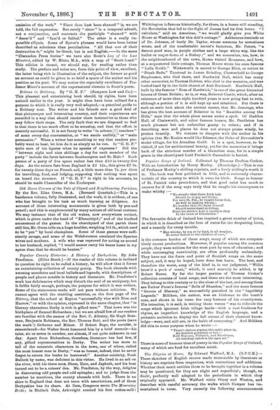The Pilgrim at Home. By Edward Walford, M.A. (S.P.C.K.)— These
sketches of English scenes made memorable by literature or history are reprints from magazines, with corrections and additions. Whether their merit entitles them to be brought together in a volume may be questioned, for they are slight and superficial ; though, no doubt, perfectly well adapted to the periodicals in which they originally appeared. Mr. Walford visits Olney and Weston, and describes with careful accuracy the walks which Cowper has im- mortalised in verse. Very recently the following announcement
appeared in a local newspaper :—" The lovely walk at Weston Underwood, through the park over the rustic bridge, through Chest- nut Walk and the spinney by the Peasant's Neat, which is familiar to all readers of Cowper, and has been used as a public footpath for at least a century, is now closed." If this statement be correct, it is to be hoped that the Society for the Protection of Footpaths will ascertain what legal right the public possess to retain one that may be said, through the genius of the poet, to have become national property. Every year the footsteps of Cowper are traced by English and American pilgrims, and it is hard that his favourite walk should be shut on his poetical disciples. Mr. Watford describes the walk with some minuteness, as well as all the objects of interest around Olney and Weston that remind him of the poet. We may observe, however, that the author is incorrect in saying that Cowper " sat Sunday by Sunday as a willing listener to Scott's Calvinistic sermons" in the little church of Weston Underwood. When Scott preached at Olney, Cowper, as he states himself, never heard him, neither did he always like what he heard of him. " I believe," he said, " no man was ever scolded out of his sins ;" and Scott was apt to scold. Moreover, when the poet removed from Olney to Weston, Scott had left the neighbourhood and was preaching at the Lock. Mr. Walford has a pleasant paper about Glastonbury, and a slight one on Strawberry Hill ; he makes a pilgrimage to Hughenden, and glances at the pictures on the walls " with a feeling of suffocation in his throat." He visits Elstow, and finds the scenery of the neighbourhood more suggestive of poetry than of prose, " though the parish is one which enjoys a world- wide renown as the birthplace and the scene of the boyhood and early manhood of the author of ' The Pilgrim's Progress.' " He visite Ufton Court, the home of Arabella Fermor, when that lady, whom Pope has banded down to fame, exchanged her maiden name for Perkins. He visits Wotton, and has a few words to say about John Evelyn and his house, which is surrounded by some of the loveliest scenery in Surrey. He writes also of Abbotsford, Melrose, and Dry- burgh, and of several other sights and shrines, but has little to say about them that is new, or likely from force of style to impress the reader. The sketches form a series of agreeable magazine articles, easy to read, and to forget ; but they are neither remarkable for matter nor for style, and scarcely merit preservation in a more lasting form.















































 Previous page
Previous page